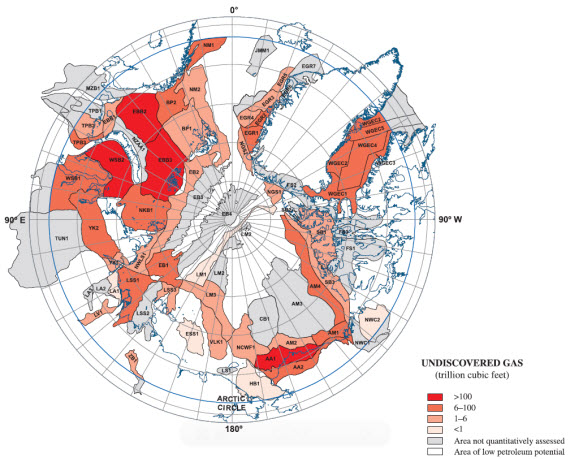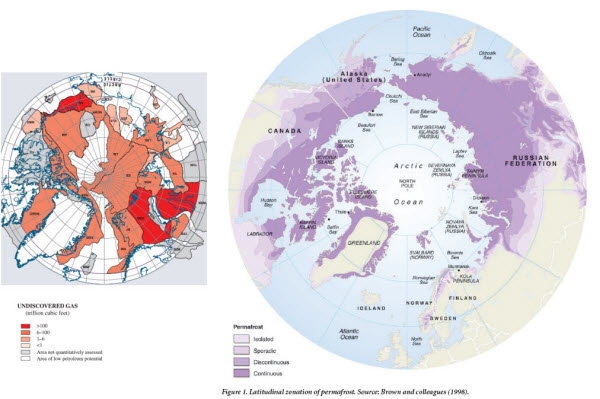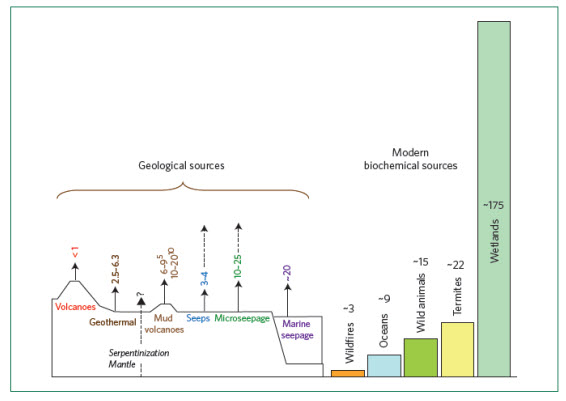Subcap Methane Feedbacks. Part 2: Quantifying fossil methane seepage in Alaska and the Arctic
Posted on 8 December 2012 by Andy Skuce
The previous article in this series looked at the recent discovery of significant releases of fossil methane through the thawing permafrost in Alaska. In this second instalment we will look at the potential of the rest of the Arctic to produce subcap methane, and will compare the size of these seeps to other global methane-producing mechanisms.
Pan-Arctic extrapolation
Much of the Arctic is underlain by sedimentary basins (Figure 1) that have potential to generate fossil methane gas. Onshore areas that are both gas- and permafrost-prone include Northern Alaska, Canada (Mackenzie Delta and Arctic Islands), Svalbard and Western Siberia.
In the Mackenzie Delta of Arctic Canada, for example, large gas seeps have been observed in small lakes in the delta close to large discovered gas fields. These seeps have isotope and chemistry signatures similar to local deep gas fields and to the Mallik gas hydrate accumulation, which contain fossil, thermogenic methane. Permafrost is up to 500 metres thick in this area but oil industry seismic reflection data reveal the presence of what may be gas conduits through the permafrost, from the deeper fossil gas accumulations (personal communication from the Geological Survey of Canada). It seems highly probable that similar situations will exist elsewhere in the Arctic, especially, in Siberia. Cramer and Franke (2006) show examples of gas conduits, some of them through permafrost, in the Laptev Sea (see also part four of this series, for more discussion).

Figure 1. (Above) USGS assessment of Arctic sedimentary basins with potential for gas. The darkest shades of red indicate the areas with the most potential. Grey areas are not assessed and white areas have only low prospectivity; from Gautier et al. (2009). Compare this map, rotated and rescaled with a map of Arctic permafrost, from Schuur et al (2008) below. Click here for big.

Extrapolating over the entire Arctic from their observations in Alaska , Walter Anthony and her colleagues estimate that subcap seeps (seeps of fossil, thermogenic methane through discontinuous permafrost) may be currently emitting as much as 2 Tg (one Teragram = one billion kilograms or one million tonnes) of methane per year. This compares to an estimated seepage of 3-4 Tg per year (Figure 2) for the rest of the world from surface seeps (excepting mud volcanoes). In Alaska, the smaller but more numerous superficial seeps currently produce about three times as much gas as the Alaskan subcap seeps.
The big question, of course, is to what extent the observed current rate of seepage is due to processes that have been going on through the past 10,000 years and how much and how quickly the subcap seepage will increase as the Arctic continues to warm. WA12 does not provide any quantitative answers to this. The supplementary information states:
A large, but transient expulsion of subcap methane is expected to increase surface carbon cycling with implications for greenhouse gas feedbacks to climate warming in a future scenario of widespread permafrost thaw and wastage of glaciers and ice sheets. The magnitude and timing of this emission scenario is unconstrained due to large uncertainties in estimating future rates of cryosphere degradation, hydrocarbon reservoir response, and potential methane oxidation.
In other words, we don’t yet know how much or how soon the release of trapped fossil methane will increase as the permafrost cap is breached as a result of climate change. In the far-distant future, after all the permafrost has been degraded, WA12 expects there to be long-term geological gas seepage at a rate of about 11 Tg per year from the entire Arctic, which would double the amount of seepage seen elsewhere on land from sedimentary basins. As the permafrost cap degrades and is perforated, we might well expect to see short-term flow rates much higher than this. We shall speculate on this in part four of this series.
Global perspective
A News & Views article in Nature Geoscience by Etiope (2012) (paywalled) accompanies the WA12 paper and contains Figure 2, which compares natural geological sources of methane.

Figure 2. From Etiope (2012), comparing global natural geological and biochemical sources of methane. The dashed arrows above the seeps and microseeps represent estimates of increases in seep rates in a far-distant future, after the melting of the permafrost and release of the subcap methane. During the melting of the permafrost on century scales there may be a faster transient release of pent-up subcap fossil methane but this has not yet been quantified. Units are Tg (million tonnes) of methane per year.
Figure 2 shows the very large natural sources of biochemical methane in relation to estimates of emissions of geological methane. Anthropogenic sources of methane are not shown in this diagram and are roughly as large as the natural biochemical sources. The natural and man-made emissions of methane are approximately balanced by chemical reactions in the atmosphere that remove methane and by methane-consuming microbes in soils. There is a comprehensive review of natural sources of methane prepared by the Environmental Protection Agency.
Because they are relatively small, geological seeps are often neglected in articles on sources of atmospheric methane (e.g., Wikipedia and the IPCC TAR). Recently, however, understanding natural seeps of methane has become important in determining baselines in areas where unconventional gas production (fracking) is contemplated, such as in New York State.
The largest sources of emission of geological methane are the human-mediated fugitive emissions associated with fossil-fuel energy production, which amount to about 100 Tg CH4 per year, eclipsing all of the natural geological emissions. Such leaks come from all stages of natural gas production and transportation: from deliberate venting; from wellheads and poorly-cemented wells; and from leaky pipelines and storage containers. (See also this link, which estimates sources of methane emissions from many human activities in the USA.) These emissions have decreased over recent decades, but they may be starting to rise again; as I wrote in a previous SkS article:
A recent paper in Nature by Simpson et al (2012) (paywalled but see also the article in Climate Central) linked observed declines in atmospheric ethane to reduced fugitive emissions of methane (and associated ethane) from oil and gas operations. Simpson and her colleagues estimate that this may have reduced methane emissions by 10-21 Tg/yr (million tonnes per year), and that this could account for 30-70% of the total decline in methane emissions since 1984. If true, this would be the only climate mitigation action ever to have shown results detectable at the Mauna Loa Observatory. On the other hand, atmospheric methane concentrations have recently started to climb again, perhaps due to recent increased rates of shale gas drilling.
A 2012 paper by O'Sullivan and Paltsev, on the other hand, suggests that methane emissions from US shale gas wells, once flaring and reduced-emission completions are taken into consideration, may be small (~4%) in relation to overall fugitive emissions from the US gas industry. They estimate that, in 2010, emissions from shale gas operations in the USA amounted to 0.2 Tg of methane.
The significance of subcap fossil methane emissions lies not so much in their current rates, nor even in the amount that they are likely to become in a post-permafrost world, but rather in the transient rate that will occur as the big Arctic thaw unfolds. I will speculate on this in part four, but before that, in the next part of this series I will look at potential methane releases resulting from the retreat of glaciers and ice sheets.































 Arguments
Arguments























 0
0  0
0






Comments